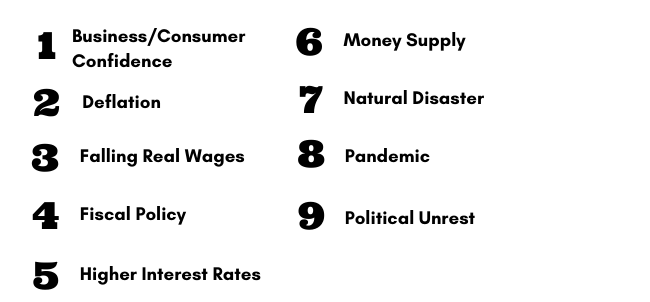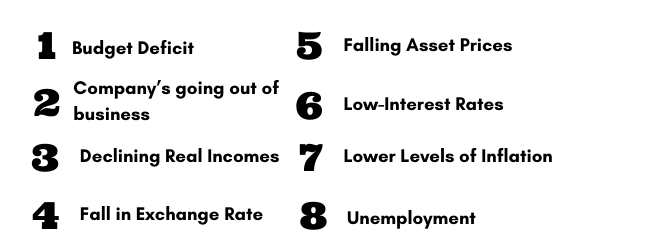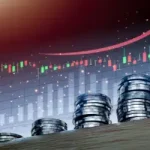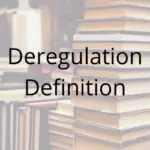Recession: Definition, Causes, Effects & Solutions
What is a Recession
In economics, a recession is defined as a decline in economic growth. More specifically, it is when an economy experiences two consecutive quarters of economic decline. This occurs when GDP falls in comparison to the previous quarter.
So an economic recession occurs when GDP falls for two consecutive quarters, but what is that made up of? GDP is made up of consumer spending, business investment, government spending, and net exports (exports – imports). So a decline in any of these may contribute to an economic recession.
An economic recession is often feared, which can actually have a self-fulfilling effect as consumers and businesses spend less. This is because confidence in the health of the economy in terms of jobs and consumer demand is affected. Once a recession is official, many fear for their jobs, so consumer spending declines, and that in turn affects the expectations of business sales.
Key Points
- An economic recession is classified as two consecutive quarters of economic decline.
- The main contributory factor of a recession is a decline in demand – this may be from consumers, businesses, government, or internationally through lower exports.
- During a recession, people lose their jobs, businesses go bust, stock markets tumble, and exchange rates tend to decline.
Causes of Recession
Economic output, or GDP, is made up of consumer spending, business investment, government spending, and net exports. So a recession will occur when any of these declines significantly, in excess of growth in the other components. For instance, a sharp decline in consumer spending may be offset by growth in government spending – leading to a net-zero impact on GDP.
A recession may happen due to a decline in one component, two components, or all four components of GDP. However, what are the factors that would cause this to happen and cause a recession?

1. Business/Consumer Confidence
Business confidence can decline due to government policies, declining consumer spending, or increases in interest rates – among others. This decline in confidence impacts on investment (one component of GDP) as businesses worry that it may not produce a suitable return.
At the same time, there is declining consumer confidence which may come from rising unemployment, weak economic growth, and higher interest rates – among others. When consumer confidence declines, consumers tend to save more in order to protect themselves during an economic decline. Lower consumer spending, therefore, results in lower demand in the economy which stimulates fewer jobs.
2. Deflation
Falling prices mean consumers push their purchasing decisions back. Instead of paying $15,000 for a car today, it’s better to wait and buy it for $14,000 next year. In turn, that reduces consumer spending and thereby wider economic activity. At the same time, it incentivizes consumers to save because their money will be worth more each year.
A reluctance from consumers to spend due to deflation can therefore cause a recession. This is because consumer spending is a key part of the economy. In turn it can also affect business investment as businesses may look to reduce the number of workers due to lower levels of demand.
3. Falling Real Wages
If the prices of goods and services increase faster than workers’ pay, it means consumers have less disposable income to spend. So instead of spending 50 percent of their income on food and rent, they may have to pay 60 percent a month. In turn, that can have a wider impact on consumer spending.
4. Fiscal Policy – Taxes and Government Spending
Fiscal policy covers what the government brings in through taxes, and what it spends (one component of GDP). In the first instance, an increase in taxes will significantly restrict consumer spending as they take less home in their pay. When consumers have less money to spend, they demand fewer goods and services – thereby affecting the wider economy.
In the second instance, if government reduces the amount it spends, it decreases the size of another component of GDP (government spending). Lower levels of government spending are also likely to affect employment. It may either hire public sector workers, or alternatively hire contracts to cover specific public services.
5. Higher Interest Rates
An increase in interest rates puts pressure on households as they pay more in terms of credit and mortgage debt. Effectively, they are paying more money to borrow the same amount. In turn, consumers’ disposable income declines – meaning they are unable to buy as many goods and services as before.
This then impacts the wider economy as demand falls, putting cost pressures onto businesses. On top of that, businesses also face cost pressures as they have to make higher repayments on their existing loans. This often results in large levels of unemployment as firms seek to cut costs – leading to a recession.
6. Money Supply
A lack of money supply was one of the main causes of the Great Depression of 1929. The economy was growing strongly, but it needed an increase in the supply of money in order to represent the new goods and services that the economy was producing. As the Federal Reserve failed to increase the supply of money into the economy, more goods were being produced, but the same amount of money was circulating. In turn, this led to one of the worst recessions in history.
For example, let us say there was $100 in the economy that represents 100 oranges at $1 each. Over time, 150 oranges are being produced, but there is only $100. That means those oranges are only worth $0.66. Consequently, the lack of money circulating in the economy meant debts were taken out which couldn’t be repaid, with more goods being produced than people could afford.
7. Natural Disaster
Natural disasters such as hurricanes and tsunamis can create massive economic damage. Usually, these disasters are limited to specific regions of the country, so the effect may be limited. For example, the 2011 earthquake and tsunami in Japan destroyed thousands of factories and homes. This had a significant impact on its manufacturing industry and sent Japan’s economy into recession. The damage was thousands of lost lives including $360 billion in damages.
8. Pandemic
In 2020, COVID-19 (Coronavirus) hit the entire global economy. It forced developed nations to completely close down their entire economies and led to one of the worst recessions ever recorded. Even when economies re-opened, consumers were still reluctant to go back to restaurants, cinemas, and other stores in fear. The resulting consequence was a prolonged recession as consumers lost their jobs and were reluctant to spend.
9. Political Unrest
Political instability affects both business and consumer confidence. This is because it creates uncertainty. Will a new government increase taxes, create new regulations, or make it difficult to do business? There may be a risk that a fascist government takes power and confiscates private property. In turn, this affects businesses willingness to invest. Not only are domestic firms put off, but also international firms. In turn, during political instability, it can affect business investment as part of GDP, and therefore cause a recession.
Effects of Recession
Many consumers in the economy will go through a recession and not even notice. Life may continue as normal, but there are far-reaching effects that indirectly impact everyone. These impacts may not necessarily occur during the recession, but many years after. For instance, the 2008 recession had far-reaching effects that continue to this day. It contributed to massive budget deficits and a massive expansion in the money supply. Across Europe, austerity took place for many years after, leading to a decline in the quality of public services.

1. Budget Deficit
When there is an economic recession, workers invariably lose their jobs as aggregate demand declines. This increase in unemployment means fewer workers contributing to payroll taxes. Those workers will then have less disposable income to spend on further goods – meaning lower government receipts from sales taxes.
We then have the fact that governments with welfare states will spend more through unemployment payments. So overall, spending increases, whilst receipts fall. In the end, the government spends more than it receives, thereby creating a budget deficit.
2. Company’s going out of business
An economic recession is associated with a decline in aggregate demand. With the overall demand in the economy declining, businesses sell fewer goods and services. This puts significant cost pressures onto businesses – it may prevent some benefiting from the same economies of scale, thereby increasing unit prices.
In addition to higher unit prices, there are ongoing fixed costs such as rent which need to be paid even though the company is selling fewer goods. If these cost pressures are too much for a business, they will end up having to fold.
3. Declining Real Incomes
During a recession, employees tend to take a hit in order to keep their jobs. They may be asked to take a pay cut, or may not see pay increases in line with inflation. As aggregate demand declines, businesses don’t have the same financial ability to hire more workers and pay higher wages, so job opportunities dry up. In turn, employees have few options apart from accepting stagnant or declining pay.
4. Fall in Exchange Rate
When a country falls into recession, central banks tend to reduce interest rates to stimulate consumer and business demand for credit. At the same time, falling stock prices and profits encourage an outflow of capital from the country. Foreign direct investment dries up due to the economic uncertainty, which then contributes to a decline in demand and weakening of the currency.
5. Falling Asset Prices
When a country falls into a recession, the value of assets such as house prices and the stock market decline. As people lose their jobs, profits fall, businesses go bust, and consumers generally see a fall in disposable income – it creates panic in the stock market and uncertainty among consumers.
The uncertainty that a recession creates filters through to asset prices. Both investors and consumers start to question an assets true value, and more importantly – when will its value stop falling. They don’t want to buy when its value is still going to fall another 30 percent, so hold off, thereby reducing demand and creating more panic to sell. Only when that confidence returns will the prices stabilise.
6. Low-Interest Rates
A recession is characterised by falling aggregate demand. That means demand from consumers and business are both falling. With consumers demanding fewer goods, it means businesses have to reduce production. In turn, it means they need fewer employees. At the same time, they are disincentivized from investing in new machinery and equipment as future demand remains uncertain.
In order to try and stimulate aggregate demand, central banks will use a number of monetary tools – one of which is lower interest rates. By making it cheaper to borrow money, it creates an incentive for both consumers and businesses to move purchasing decisions forward. For example, it may cost $50,000 less for a consumer to move homes due to a lower rate. Alternatively, a more productive machine may cost $20,000 less to business.
7. Lower Levels of Inflation
When a recession hits, consumers demand fewer goods and services in the economy. Businesses react by lowering prices to attract customers back – thereby reducing inflation in the economy. At the same time, there is usually a sharp contraction in debt which also reduces the supply of money circulating in the economy.
8. Unemployment
Unemployment and recessions go hand in hand. The reason being is that when employment is stable, people are working and producing an economic output. When those jobs are no longer needed, they are lost, and so is that economic output. This is driven by declining demand in the economy, which could be triggered by a number of factors. However, it means that fewer goods and services and needed and in turn, the employees that produce them.
Solutions to an Economic Recession
The main cause of an economic recession is a decline in demand within the economy – whether from businesses, consumers, government, or from other nations. Therefore, the most effective solution will depend on the root cause of the recession.
If consumer spending has suffered a slump, it may be best to reduce taxes. This will give them additional income and allow encourage greater spending in the economy. Alternatively, a slowdown in business investment may require lower interest rates to reduce the debt burden.
1. Reduce Taxes
When governments reduce taxes, it often comes at the cost of widening the budget deficits. The government receives less in tax receipts, but usually keep spending at the same level – that way the economy receives an aggregate boost. Whilst this increases the budget deficit, it puts more hands into the pockets of the average consumer.
The effectiveness of a reduction in tax will depend on the marginal propensity to consume. In other words, what percentage of that income is going to be spent in the wider economy. If the propensity to consume is high, then consumers may spend all of the tax-break at the shops. In turn, further goods and services are being demanded, which creates jobs and boosts the economy.
2. Increase in Government Spending
Government spending itself is a component of GDP, so any increase here would create an aggregate boost in the economy. However, this can come at a cost in the long term – either through higher rates of inflation, or higher taxes. Both of which can cause a significant drain to economic growth.
With that said, an increase in government spending can create a significant boost to the economy. Public work programs and investment in infrastructure help put money in the hands of workers, who are then able to go out and spend it and boost the wider economy. At the same time, such programs are more cost-effective because the government doesn’t have to pay welfare benefits for those it hires. So instead of paying welfare payments, the government is paying a wage instead – meaning the effective cost is less.
3. Quantitative Easing
Most central banks use quantitative easing to flood the market with new money, with the intention of liquidating the credit markets – making it easier for financial institutions to lend money. The central bank buys government debt from financial institutions, which then frees them up to lend to consumers and businesses. Alternatively, the institutions may simply just buy fresh government debt – if it chooses to borrow more.
The financial institutions will have a number of options to move the fresh cash – although this is not always effective. As we saw during the 2008 financial crisis, banks kept the newly minted money in their reserve accounts as the risk of lending it out was too great. Nevertheless, quantitative easing can potentially increase economic growth if the money filters through to consumers, businesses, and potentially, the government.
4. Reduce Interest Rates
By lowering interest rates, the central bank essentially puts more money back into the pockets of consumers and businesses – which encouraging savers to spend their money. So consumers with variable-rate mortgages will pay less to their provider each month. Instead, they have that additional stream of income to spend in the economy.
Lower interest rates also mean businesses have to pay back less – providing a boost to the firm’s cash flow. These lower rates also make it cheaper to borrow, which creates an opportunity for firms to invest in better equipment.
5. Remove Regulations
One of the issues many firms face is the long list of regulations they have to abide by. Not only do many create additional costs to business, but also the cost to the consumers. By removing regulatory hurdles, it not only reduces the efficiency of the business but also makes goods cheaper for consumers.
We also have other regulations such as labour laws. By making it easier for firms to hire and fire, it creates a greater incentive for businesses to start investing in new employees. That could get the economy started again as more people join the workforce, thereby generating an economic output and spending money.
Related Topics
FAQs on Recession
During a recession, people lose their jobs, businesses go bust, stock markets tumble, and exchange rates tend to decline.
A recession is when there are two consecutive quarters of negative economic growth, as measured by GDP.
There are many individual causes of a recession, but the main contributory factor is declining demand. This may be from consumers, businesses, government, or internationally through lower exports.
About Paul
Paul Boyce is an economics editor with over 10 years experience in the industry. Currently working as a consultant within the financial services sector, Paul is the CEO and chief editor of BoyceWire. He has written publications for FEE, the Mises Institute, and many others.

Further Reading
 Present Value: Definition, Criticisms & Example - Present value (PV) is the current value of a future sum of money, or stream of revenue. Tihs is calculated…
Present Value: Definition, Criticisms & Example - Present value (PV) is the current value of a future sum of money, or stream of revenue. Tihs is calculated…  Deregulation: Definition, Pros, Cons & Examples - Deregulation is where governments reduce the level of interference that they have in the marketplace. This involves looking at previous…
Deregulation: Definition, Pros, Cons & Examples - Deregulation is where governments reduce the level of interference that they have in the marketplace. This involves looking at previous…  Unit Elastic - Unit elastic demand refers to a situation where a change in price leads to an equivalent proportional change in quantity…
Unit Elastic - Unit elastic demand refers to a situation where a change in price leads to an equivalent proportional change in quantity… 